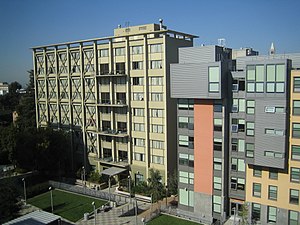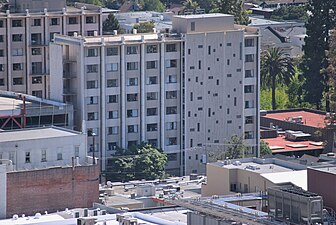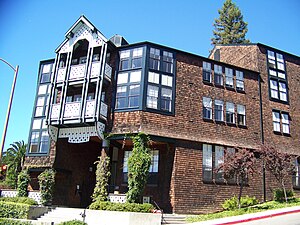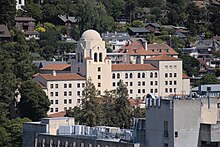This article has multiple issues. Please help improve it or discuss these issues on the talk page. (Learn how and when to remove these messages)
|

Housing at the University of California, Berkeley, includes student housing facilities run by the office of Residential and Student Service Programs (RSSP). Housing is also offered by off-campus entities such as fraternities and sororities and the Berkeley Student Cooperative (BSC).
History
330yds 18
- Residence halls
- Apartments
- Unaffiliated
1 Unit 1 (Cheney | Christian | Freeborn | Putnam | Slottman | Deutsch)
2 Unit 2 (Cunningham | Towle | Davidson | Griffiths | Wada | Ehrman)
3 Unit 3 (Norton | Spens-Black | Priestly | Ida Sproul | Beverly Cleary)
4 Unit 4 (Stern | Foothill)
5 Unit 5 (Clark Kerr)
6 David Blackwell
7 Martinez Commons
8 Channing-Bowditch
9 Enclave
10 Ida L. Jackson
11 Intersection (Emeryville)
12 Manville
13 New Sequoia
14 Panoramic Berkeley
15 University Village (Albany)
16 International House Berkeley
17 Bowles Hall
18 Berkeley Student Cooperative (Casa Zimbabwe)
Historically, the University of California adhered to the traditions of the great German research universities, and as part of that, largely refrained from providing housing for students for over 80 years after its 1868 founding. By the fall of 1954, only 4.8% of UC Berkeley students were housed in university-operated residence halls, while the equivalent number at archrival Stanford University was 36.0%. Nearly all the student body and some of the faculty had to fend for themselves in seeking space in privately operated rooming houses in surrounding cities, many of which were in very poor condition.
When Clark Kerr became the first chancellor of UC Berkeley in 1952, he became aware of a tacit understanding under which the university had traditionally refrained from competing against privately operated housing and dining facilities, and that conservative members of the Board of Regents had traditionally regarded university-operated housing as tantamount to "socialism." To compete against Stanford, the Ivy League, and the Big Ten for the brightest American students, Kerr worked to shift UC Berkeley from the German model to the English model in which universities take responsibility for providing and operating student housing. In August 1956, he secured approval from the Board of Regents of a long-range development plan which included the construction of several high-rise residence halls.
University housing and dining facilities
Residence Halls
The high-rise buildings of Units 1 (1960), 2 (1960), and 3 (1964) were designed by John Carl Warnecke; each unit as first completed in the 1960s had four tall buildings surrounding a courtyard with common facilities, including a ground-level dining area above a mail room, recreation room, and office structure. Since their completion, new residential buildings have been added and the dining commons for Units 1 and 2 have been consolidated in the block separating the two complexes. Some of the newest residence hall buildings are at Units 1, 2, and 3.
Each nine-story building is named after alumni or faculty and were originally designed for single-sex occupancy and configured with a ground floor lobby and recreation room. Each room on the floor was a double or triple occupancy.
Units 1, 2, and 3 have since become co-ed although there are single-sex floors in many of the buildings. As a result of the 1989 Loma Prieta earthquake, additional cross bracing was added to the exteriors of the older highrise Unit 1 and 2 buildings.
Selected residence halls host Theme Programs, where students with common identities and interests can live together; students who choose to live in Theme Program communities are required to enroll in theme-specific courses. Current theme programs and locations include:
| Theme | Name | Unit | Hall |
|---|---|---|---|
| African-American culture | AATP | 1 | Christian |
| Asian American culture | Bloom | 2 | Cunningham |
| Mexican, Chicanx, Latinx culture | Casa Magdalena Mora (CASA) | 3 | Beverly Cleary |
| Sustainable living | Global Environment Theme House (GETH) | 5 | Clark Kerr |
| Native American culture | NATP | 1 | Slottman |
| South Asian, Southwest Asian, and North African culture | SSWANA | 2 | Cunningham |
| LGBTQ+ community | UNITY | 3 | Spens-Black |
| Female-identified students in science, technology, engineering, arts, and mathematics | Empowering Womxn in STEAM (WISE) | 4 | Stern |
- Residence Halls at Berkeley
-
 Cunningham Hall and Towle Hall (Unit 2)
Cunningham Hall and Towle Hall (Unit 2)
-
 Spens-Black Hall (Unit 3)
Spens-Black Hall (Unit 3)
-
 Foothill - La Loma (Unit 4)
Foothill - La Loma (Unit 4)
Unit 1
The six main buildings of Unit 1 (completed in 1960) are located at 2650 Durant Avenue. These include the four original highrise buildings with eight residential floors each: Cheney, Deutsch, Freeborn, and Putnam; each floor has a mixture of double and triple rooms with a shared, communal bathroom, and each building has a total of approximately 230 beds. In addition, there are the newer Christian and Slottman Halls (completed in 2005), which house two-bedroom mini-suites with a shared bathroom for four people per suite. The unit's primary dining hall is Crossroads, which it shares with Unit 2. Underneath the central quad, there is an exercise room and a computer lab.
Unit 2
The main buildings of Unit 2 (completed in 1960) are located at 2650 Haste Street. It consists of the original four highrise buildings: Cunningham, Davidson, Ehrman, and Griffiths Halls, sharing the same general configuration as Unit 1 (eight residential floors with double and triple rooms and a total of approximately 230 beds each), as well as the newer Towle Hall with two-bedroom, four-person mini-suites, and the Wada Hall apartments, both completed in 2005. The unit's primary dining hall is Crossroads, which it shares with Unit 1. Like Unit 1, Unit 2 has an exercise room and computer lab underground.
Unit 3
Unit 3 (completed in 1964) is located at 2400 Durant Avenue. The original buildings are Ida Sproul, Norton, Priestly, and Spens-Black Halls, sharing the general design and layout with Units 1 and 2. Beverly Cleary Hall, completed in 1992, is located across Channing Way and is part of the unit. The unit's main dining facility, Cafe 3, is located in the center of the original building complex.
Unit 4
Unit 4 consists of Stern Hall and Foothill Student Housing at 2700 Hearst Avenue. Bowles Hall (completed in 1929) was also part of Unit 4 until May 2015. The unit is located on the eastern edge of campus along Gayley Road. Its main dining facility is located in Foothill.
Stern Hall, built in 1942, is the only all-female residence hall on campus. It has a mixture of residence hall-style rooms with single, double, and triple occupancy and shared bathrooms, and suites with double bedrooms. It is located adjacent to Foothill.
Foothill was completed in 1990 and consists of the Hillside and La Loma complexes with a total of seven residential buildings. It is a coed residence hall popular among engineering students due to its proximity to the College of Engineering on the north side of campus. All rooms are arranged in suites with a total of three to eleven bedrooms each; each bedroom has single, double, triple, or quadruple occupancy.
Bowles was considered initially as the campus for the executive education program at the Haas School of Business, but this reuse was ruled out as contrary to the spirit in which it was funded.
Unit 4 is the only unit to not be certified ADA accessible.
Clark Kerr Campus (Unit 5)
Clark Kerr Campus at 2601 Warring Street is a Spanish mission style residential complex located 5 blocks southeast of the main Berkeley campus. Student housing includes both residential halls and suites with single, double, triple, or quadruple accommodation bedrooms. Formerly the California Schools for the Deaf and Blind, completed in 1949, the City of Berkeley and the University of California fought for the land when the school relocated in 1980. The university won the majority of the land in court and opened the converted residence hall in 1983. The campus, which was listed on the National Register of Historic Places in 1982, has its own dining hall as well as a pool, tennis court and volleyball courts.
David Blackwell Hall
At its opening on July 21, 2018, the 185,000 sq ft (17,200 m) David Blackwell Hall at 2401 Durant Avenue had 412 rooms that could house 777 residents. The hall was named after David Blackwell, the first black tenured professor of the university. The bedrooms are mostly double occupancy, with a few single rooms. It features amenities such as a fitness center, patios, gaming rooms, study areas, presentations rooms, lounges, and laundry rooms. There is no dining hall within Blackwell Hall, but residents' meal plans can be used at the nearby Café 3. Priority for housing at the hall is given to returning sophomores and upperclassmen.
University-owned apartments
Berkeley owns several apartment facilities, primarily aimed at upperclassmen and graduate students. The apartments are considered "off-campus living" for financial aid purposes. Unlike residence halls, tenants of the apartments pay monthly rent, rather than semester fees, and are not automatically included on the campus meal plan.
Channing-Bowditch
The Channing-Bowditch Apartments, completed in 2004 at 2535 Channing Way (at the intersection with Bowditch) are open to upperclassmen and transfers. There are 228 beds in total, arranged in 52 units with four beds each (2×2-bedroom units with a shared bathroom), 3 units with four beds each (4×1-bedroom), and 2 townhouses with five beds each (four bedrooms, each with single or double occupancy). They house 226 students and were completed in 2003.
Ida L. Jackson Graduate House
Jackson House, completed in 2002 at 2333 College Avenue contains apartments open to graduate students. It has a capacity of 120, in two-, three-, four-, five-, or six-bedroom apartments. Both Jackson and Channing-Bowditch were designed by PYATOK, which also handled the renovation of Bowles Hall.
Intersection Apartments
The Intersection Apartments are at 3800 San Pablo Avenue in Emeryville, approximately 3 mi (4.8 km) south of campus. There are studio, junior one-bedroom, one bed/one bath, two bed/one bath, two bed/two bath, and four bed/three bathroom apartments; all offer single-occupancy bedrooms and are fully furnished.
Manville Apartments
The Manville Apartments at 2100 Channing Way are prioritized for law and graduate students. There are 132 single-occupancy studio apartments.
Martinez Commons

The Maximino Martinez Commons at 2520 Channing Way contains both residence hall rooms and apartments. There are 52 apartments in total, 47 four-bedroom and 5 five-bedroom, each of which are single-occupancy and single-gender. Priority is given to sophomores, upperclassmen, and incoming transfer students.
New Sequoia Apartments
The New Sequoia Apartments at 2441 Haste Street houses 116 students in 42 fully furnished apartments: 1 bedroom/1 bath (two beds total), 2 bedroom/1 bath (two beds total), and 2 bedroom/1 bath (four beds total).
Panoramic Berkeley Apartments
The Panoramic Berkeley Apartments at 2539 Telegraph Avenue are considered on-campus housing, and nine-month leases are available for undergraduates. The apartments are 4 bedroom/1.5 bath, 4 bedroom/1 bath, and 5 bedroom/1.5 bath, all single-occupancy.
Wada Apartments
The Wada Apartments are within Unit 2 at 2650 Haste Street; they also are considered on-campus housing and leases are limited to ten months. Each apartment has two or three bedrooms, and the bedrooms are double or triple occupancy.
Family housing
Students with families are eligible to live in University Village's East or West Village. development.
University Village
Main article: University Village, Albany, CaliforniaUniversity Village is a housing community for married students. It is located within the city limits of Albany about two miles (3 km) northwest of the main Berkeley campus. The demolition of older buildings and their subsequent replacement with new, more expensive apartment units has prompted student protests. The Village Residents Association, a funding and advocacy group in University Village, filmed a video documentary regarding the lack of affordable student family housing in June 2007.
Smyth-Fernwald
Southeast of the Berkeley campus, the Smyth-Fernwald site is roughly a ten- to fifteen-minute walk to the main campus. Before its complete demolition in March 2013, the complex had two- and three-bedroom apartments, and housed 74 families.
The complex included a multipurpose building, with the western section containing offices and a community center. In 1999, due to creep structural damage and safety concerns, some complex buildings south of the multipurpose building were demolished.
Non-university housing
There are several large residences offering student housing, not affiliated with the university.
International House

The International House (or I-House) is located at the intersection of Bancroft and Piedmont. It is home to many of Berkeley's international students, with half international and half American residents. The International House is an independent, self-supporting non-profit organization that has close associations with the university. International House Berkeley officially opened on August 18, 1930. It was the largest student housing complex in the Bay Area and the first coeducational residence west of the Mississippi.
Bowles Hall

Bowles Hall was built in 1928 as a residential college, the first in the United States. It later became a standard Berkeley residence hall. After remodeling and reorganization by a group of Bowles Hall alumni, it reopened as a coed residential college housing students from all four undergraduate years.
Berkeley Student Cooperative
Main article: Berkeley Student CooperativeThe Berkeley Student Cooperative (BSC) (formerly known as the University Students' Cooperative Association (USCA)) is a nonprofit student housing cooperative controlled by its student membership. The BSC primarily serves UC Berkeley students, though full-time students from any accredited institution of higher education are eligible for membership (i.e. a room and/or board contract). The BSC houses approximately 1250 students in 20 properties (17 of which it owns and three of which it leases from UC Berkeley), while other members have boarding-only (i.e. meal plan) contracts. The BSC is legally independent of the university, with their only legal relationship being the aforementioned ground leases.
The BSC is significantly less expensive than both private housing and UC Berkeley-run housing (for both housing-only contracts and food and housing contracts). The BSC keeps rents low in part by requiring its members to perform "workshift" (essentially chores), usually 5 hours per week at most properties. Other methods of keeping rents low include bulk purchasing and the lack of a for-profit landlord.
The BSC offers priority to students in the UC Berkeley Educational Opportunity Program (EOP) (or equivalent at their respective college or university), students with disabilities, transfer students, undocumented students, and international students studying abroad at a University of California campus.
References
- ^ Kerr, Clark (2001). The Gold and the Blue: A Personal Memoir of the University of California, 1949–1967. Vol. 1: Academic Triumphs. Berkeley: University of California Press. ISBN 0-520-22367-5. Retrieved 11 November 2021.
- ^ "Residence Hall". University of California, Berkeley; Disability Access & Compliance. Retrieved 12 January 2023.
- Gallagher, Noel (11 January 2005). "New residence halls, new students arrive for spring semester" (Press release). UC Berkeley News.
- "Be a Big Part of a Small Community". University of California, Berkeley Residential Life. Retrieved 12 January 2023.
- "African American Theme Program". University of California, Berkeley Residential Life. Retrieved 12 January 2023.
- "Bloom: Asian American Community Program". University of California, Berkeley Residential Life. Retrieved 12 January 2023.
- "Casa Magdalena Mora Theme Program". University of California, Berkeley Residential Life. Retrieved 12 January 2023.
- "Global Environment Theme House". University of California, Berkeley Residential Life. Retrieved 12 January 2023.
- "Native American Theme Program". University of California, Berkeley Residential Life. Retrieved 12 January 2023.
- "South Asian, Southwest Asian, and North African Living Community Pilot Program". University of California, Berkeley Residential Life. Retrieved 12 January 2023.
- "UNITY Theme Program". University of California, Berkeley Residential Life. Retrieved 12 January 2023.
- "Empowering Womxn in STEAM". University of California, Berkeley Residential Life. Retrieved 12 January 2023.
- "Unit 1". University of California, Berkeley Housing. Retrieved 10 September 2013.
- "Unit 2". University of California, Berkeley Housing. Retrieved 10 September 2013.
- "Unit 3". University of California, Berkeley Housing. Retrieved 10 September 2013.
- "Stern (Unit 4)". University of California, Berkeley Housing. Retrieved 10 September 2013.
- "Foothill (Unit 4)". University of California, Berkeley Housing. Retrieved 10 September 2013.
- DelVecchio, Rick (July 15, 2007). "BERKELEY / UC backs down on plan to convert dorm". SF Gate. Retrieved 11 January 2023.
- Welcome to RSSP Housing Projects, UC Berkeley
- The Daily Californian – City Grants Foothill Bridge Permit
- Donald MacDonald FAIA Bridge Architects
- "Clark Kerr (Unit 5)". University of California, Berkeley Housing. Retrieved 10 September 2013.
- "National Register Information System – State Asylum for the Deaf, Dumb and Blind | California Schools for the Deaf and Blind (#82000962)". National Register of Historic Places. National Park Service. November 2, 2013. Retrieved January 12, 2023.
- "Blackwell Hall". University of California, Berkeley Housing. Retrieved 11 January 2023.
- Chin, Nathan (2018-08-10). "David Blackwell Hall opens doors to incoming students". The Daily Californian. Retrieved 2022-05-18.
- ^ "Channing-Bowditch Apartments". University of California, Berkeley Housing. Retrieved 10 September 2013.
- "Ida L. Jackson Graduate House". University of California, Berkeley Housing. Retrieved 10 September 2013.
- "Student Housing archive". Pyatok. Retrieved 12 January 2023.
- "UC Berkeley Channing-Bowditch Apartments". Pyatok. Retrieved 12 January 2023.
- "UC Berkeley Bowles Hall residential college renovation". Pyatok. Retrieved 12 January 2023.
- "Intersection Apartments". University of California, Berkeley Housing. Retrieved 10 September 2013.
- "Manville Apartments". University of California, Berkeley Housing. Retrieved 10 September 2013.
- "Martinez Commons". University of California, Berkeley Housing. Retrieved 10 September 2013.
- ^ "New Sequoia Apartments". University of California, Berkeley Housing. Retrieved 10 September 2013.
- "Wada Apartments". University of California, Berkeley Housing. Retrieved 10 September 2013.
- "Students with Families." University of California Berkeley. Retrieved on 2 October 2011.
- Affordable Student Family Housing – UC Berkeley
- "Smyth Fernwald." Smyth Fernwald. Retrieved on October 2, 2011. "Dwight Way & Fernwald Rd."
- "The Smyth Fernwald Complex." UC Berkeley Housing. Retrieved on October 2, 2011. "Dwight Way & Fernwald Rd."
- Taylor, Tracey. "." Berkeleyside. March 7, 2013. Retrieved on October 31, 2014.
- "Smyth-Fernwald Residential Complex." (Archive) UC Berkeley Geology. Retrieved on October 2, 2011.
- ^ Berkeley Student Cooperative. "General Information". Berkeley Student Cooperative. Retrieved January 23, 2019.
- Berkeley Student Cooperative. "Ownership Status". BSC Policy Wiki. Berkeley Student Cooperative. Retrieved January 23, 2019.
- Berkeley Student Cooperative (August 18, 2011). "Articles of Incorporation". BSC Policy Wiki. Berkeley Student Cooperative. Retrieved January 23, 2019.
- Berkeley Student Cooperative. "BSC Bylaws". BSC Policy Wiki. Berkeley Student Cooperative. Retrieved January 23, 2019.
- Berkeley Student Cooperative. "Workshift". Berkeley Student Cooperative. Retrieved January 23, 2019.
- Berkeley Student Cooperative. "Assignment of Spaces". BSC Policy Wiki. Berkeley Student Cooperative. Retrieved January 23, 2019.
External links
- Cal Housing official website
- UC Berkeley's Residence Hall Assembly Website
- History of the Residence Halls, on freebornhall.com
- Unit 1 Website
- Unit 2 Website
- Theme Program official webpage @ Cal Housing
- International House Website
- Student Family Housing - Problem & Solution (video documentary)
- Cal Greeks - Fraternities & Sororities
- Berkeley Student Cooperative
| University of California, Berkeley | |||||||||||
|---|---|---|---|---|---|---|---|---|---|---|---|
| Located in: Berkeley, California | |||||||||||
| Academics |  | ||||||||||
| Athletics |
| ||||||||||
| Campus |
| ||||||||||
| Research | |||||||||||
| Activities | |||||||||||
| Related | |||||||||||
| |||||||||||
37°52′04″N 122°15′19″W / 37.8678°N 122.2552°W / 37.8678; -122.2552
Categories: